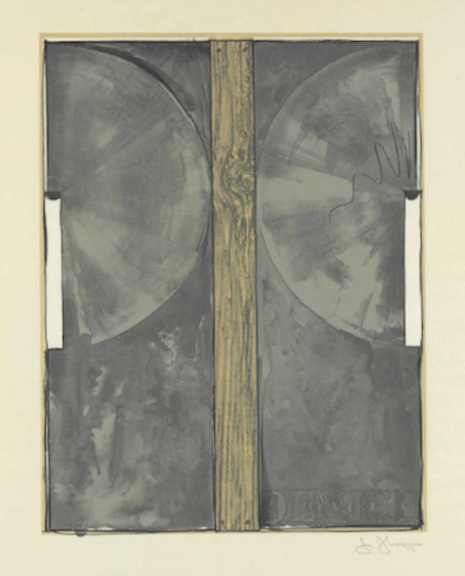Jasper Johns, Device
Jasper Johns
Device
1971-72
Lithograph
38 1/2 x 29 in.
Edition of 62
This piece is signed and numbered in pencil.
About This Work:
Device is an important work from Japser Johns’ gray period, as it is derived from his famous painting Device (1962-63), which shows his experimentation with mechanism and its relation to the artist’s hand.
In the early 1960s, Johns introduced a new process-driven motif referred to as “device” that he used to make his works. He would apply paint with a studio or household object rather than a paint brush, and then often affix those objects to the canvas. For Johns, the “device” whether ruler, wooden slat or broom is an extension of the artist’s hand, much like the paint brush.
Works from John’s gray period are highly sought after. For Johns, the color gray, serves as a means of emphasizing the physical properties of an object by draining it of color. However, his use of gray as a color draws attention to the condition of gray itself, elevating it to more than a color, but also as an idea and material.
About The Artist:
In the late 1950’s, Jasper Johns emerged as force in the American art scene. His richly worked paintings of maps, flags, and targets led the artistic community away from Abstract Expressionism toward a new emphasis on the concrete. Johns laid the groundwork for both Pop Art and Minimalism. Today, his prints and paintings set record prices at auction.
Born and raised in Allendale, South Carolina, Jasper Johns grew up wanting to be an artist. He studied briefly at the University of South Carolina before moving to New York in the early fifties.
After a visit to Philadelphia, with his good friend Robert Rauschenberg, to see Marcel Duchamp’s painting, The Large Glass (1915-23), Johns became very interested in his work. Duchamp had revolutionized the art world with his “readymades” — a series of found objects presented as finished works of art. This irreverence for the fixed attitudes toward what could be considered art was a substantial influence on Johns.
The modern art community was searching for new ideas to succeed the pure emotionality of the Abstract Expressionists. Johns’ paintings of targets, and maps, invited both the wrath and praise of critics. Johns’ early work combined a serious concern for the craft of painting with an everyday, almost absurd, subject matter. The meaning of the painting could be found in the painting process itself. It was a new experience for gallery goers to find paintings solely of such things as flags and numbers.
The simplicity and familiarity of the subject matter piqued viewer interest in both Johns’ motivation and his process. Johns explains, “There may or may not be an idea, and the meaning may just be that the painting exists.”
In 1958, gallery owner Leo Castelli visited Rauschenberg’s studio and saw Johns’ work for the first time. Castelli was so impressed with the 28-year-old painter’s ability and inventiveness that he offered him a show on the spot. At that first exhibition, the Museum of Modern Art purchased three pieces, making it clear that at Johns was to become a major force in the art
Over the past fifty years Johns has created a body of rich and complex work. His rigorous attention to the themes of popular imagery and abstraction has set the standards for American art. Constantly challenging the technical possibilities of printmaking, painting and sculpture, Johns laid the groundwork for a wide range of experimental artists. Today, he remains at the forefront of American art, with work represented in nearly every major museum collection.

